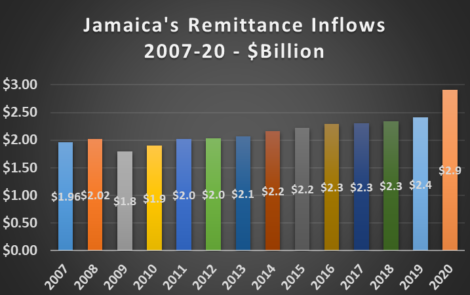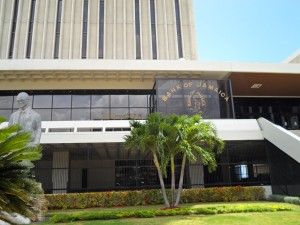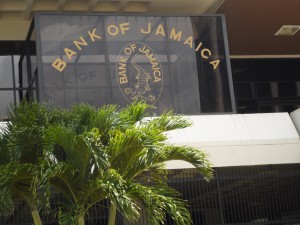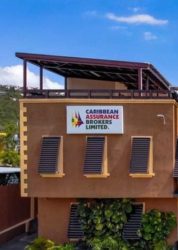 Total remittance inflows climbed a respectable 8.8 percent for an increase of US$24 million to US$296 million, up from US$272 million in 2020.
Total remittance inflows climbed a respectable 8.8 percent for an increase of US$24 million to US$296 million, up from US$272 million in 2020.
The increase continues the robust growth remittance inflows enjoyed since May last year. It puts the total inflows for the year to date at US44 million short of the total intake for 2020, when US$2.905 billion was taken in for the year to the end of December. At the pace inflows have grown, the take for the current year could hit a record US$3.5 billion, data released by the Bank of Jamaica is suggesting.
Jamaica’s remittances up again in October
Remittances jump 17% in September
 Total remittance inflows in Jamaica jumped 17.2 per cent or US$44.8 million in September 2021 over the $260 million inflows for September 2020 and lifting the gross inflows for the year to date to US$2.6 billion, just US$300 million less than US$2.9 billion inflows for the 2020 calendar year.
Total remittance inflows in Jamaica jumped 17.2 per cent or US$44.8 million in September 2021 over the $260 million inflows for September 2020 and lifting the gross inflows for the year to date to US$2.6 billion, just US$300 million less than US$2.9 billion inflows for the 2020 calendar year.
The increase for the month is highly positive, in light of a strong 34.5 percent jump in September 2020 over the 2019 inflows for that month.
The total inflows for last year could be equalled or exceeded with the October numbers and could put the inflows for the year at US$3.6 billion by the end of the year. The numbers for September continues the robust monthly increase since last year May, except for a small decline of 2.4 percent in August this year. For the January to August 2021 period, remittance inflows to Jamaica grew by 25.4 percent to US2.3 billion, up from US$1.836 billion in 2020. Prior to August, inflows grew by 30.4 percent, with June and July being up 10 percent, well below 42 percent increase to May.
The data was obtained from the Bank of jamaica.
Have Interest rates peaked?

Jamaica’s Central Bank
Interest rates on Certificate of Deposit issued by Bank of Jamaica seem to be levelling off, with the rate at last week’s auction declining from the previous week’s outturn.
Last week’s offer of $7.5 billion in 30 days on Wednesday, 27 October, attracted 76 applications amounting to $13 billion and resulted in an average yield of 3.96 percent, down from 4.53 percent at the auction in the previous week. Bids were received as low as 2.5 percent covering $1.48 billion, with the highest rate bid being 7.34 percent for $20 million. A bid amounting to $550 million received full allocation at 4.79 percent. The total nominal outstanding amount for the 30-day CDs on the settlement date – 29 October, will be $41.5 billion, down from $46.5 billion in mid-October.
BOJ one year CDs 2.74%
 Bank of Jamaica’s one-year CD offering of $4.5 billion on Thursday, October 21, ended with an average interest rate of 2.74 percent, much lower than the 4.53 percent the 30 days CD cleared at this past week.
Bank of Jamaica’s one-year CD offering of $4.5 billion on Thursday, October 21, ended with an average interest rate of 2.74 percent, much lower than the 4.53 percent the 30 days CD cleared at this past week.
The one year instrument attracted 107applications amounting to $15.88 billion, of which only 27 were successful. The highest bidding rate was 8.99 percent for $423 million, but the highest successful rate was 4.76 percent, resulting in 29.4 percent of the amount applied for being accepted by the Bank of Jamaica. The highest rate payable on the full amount of $140 million applied for was 4.5 percent, while the lowest rate applied for was 1.495 percent on $400 million.
The issue is likely to be regarded by the country’s central bank as highly successful. The success of the issue should result in more longer term offerings to lock up liquidity in the market on a longer term basis than the 30 days instruments that are more costly for the bank and more challenging to manage as they mature on a more frequent basis.
Jamaica is now seeing rising interest rates following the Central Bank’s decision in August to raise as a result of surging inflation. Following that decision, 30 day CD rates climbed sharply and the Bank raised its Overnight rate from 0.50 percent to 1.5 percent in September.
BOJ now paying over 4% on CDs
Interest rates rose to 4.17 percent in the latest Bank of Jamaica 30 day CD offering of 12 billion on Wednesday last week, up from 3.28 percent on Wednesday, October 6 and well over the new overnight rate of 1.5 percent.
 Having settled at a low of just over 0.5 percent for the past two years, the latest rate marks a significant shift in a very short time frame, a development that investors should watch carefully.
Having settled at a low of just over 0.5 percent for the past two years, the latest rate marks a significant shift in a very short time frame, a development that investors should watch carefully.
At the recent auction, the central bank received 53 bids amounting to $14 billion for $12 billion on offer, 46 bids were successful up to 5.27 percent and came after BOJ increased their overnight rate to 1.5 percent. The total nominal outstanding amount for the 30-day CDs $46.5 billion, similar to the week before, but well above the $35.5 billion at the end of July.
At the same time, the Government of Jamaica Treasury bill auction on Wednesday, October 10, rates on the three tenors on offer ended with an average rate of 2.165 percent for the 90 day offer that attracted $2.246 billion for the $700 million on offer. The 181 days offer saw $1.974 billion chasing the $700 million offered and resulted in an average rate of 2.75 percent and the 273 days T-bill pulled in $1.865 billion for $800 million offered and resulted in an average rate of 3.69 percent.
The range for yields for full allotment is 1.45 percent to 2.85 percent for the 91 day T-Bill, 1.5 percent to 3.05 percent or the 182 days T-bill and 2.41 percent to 4.75 percent for the longest dated bill.
On Thursday, October 21, the central bank will auction $4.5 billion 365 days Certificate of deposit.
Bank of Jamaica hikes ON rate to1.5%
 Bank of Jamaica, the central Bank of Jamaica day raise their Over Night interbank rate by one percentage to 1.5 percent. The rise follows the Bank’s announcement at the end of August that the announced the decision to consider commencing a tightening of monetary policy at the next meeting of the Bank’s Monetary Policy Committee in September and to immediately implement other measures aimed at moderating inflation expectations, including the containment of Jamaican dollar liquidity expansion.
Bank of Jamaica, the central Bank of Jamaica day raise their Over Night interbank rate by one percentage to 1.5 percent. The rise follows the Bank’s announcement at the end of August that the announced the decision to consider commencing a tightening of monetary policy at the next meeting of the Bank’s Monetary Policy Committee in September and to immediately implement other measures aimed at moderating inflation expectations, including the containment of Jamaican dollar liquidity expansion.
A precursor to the policy rate increase and further tightening of the financial market, the CDs offered by the BOJ on September 29 resulted in a continuation in the rise of CD rates to 2.59 percent from 0.59 percent at the end of July.
The overnight rate was last cut to 0.50 percent in August 2019. It remained at that level up to the end of September. It ultimately dragged other rates in the system down and resulted in significant savings in interest costs for the government.
Consistent with meeting its inflation target sustainably in the medium term, the MPC agreed to continue increasing the Bank’s policy rate and by extension raising real interest rates, which are currently significantly negative and maintaining or intensifying the accompanying measures. This position is subject to inflation and other macroeconomic data evolving as projected.

 At the beginning of August, when the total amount of CDs was $35 billion, BOJ offered just $8 billion into the market and resulted in bids of $20.22 billion and resulted in an average interest rate of 0.59 percent, with the highest successful bid ending with a yield of just 0.62 percent, just higher than the banks overnight rate of 0.50 percent.
At the beginning of August, when the total amount of CDs was $35 billion, BOJ offered just $8 billion into the market and resulted in bids of $20.22 billion and resulted in an average interest rate of 0.59 percent, with the highest successful bid ending with a yield of just 0.62 percent, just higher than the banks overnight rate of 0.50 percent.




